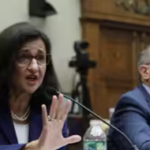By Collin Binkley, AP
Pittsburg Courier, October 17, 2016 —

For most college freshmen they will be participating in a presidential election for the first time. That’s the case for University of Pittsburgh students Evelyn Okorie, Isanny Rosario, and Dominique Ellison. Their friend, Ivie Odia, 17, of New York, said although she will not be able to vote, she can convince her parents to make the right choice. (Photo by Merecedes J. Howze/File)
BOSTON – Black and Latino students in the U.S. are far less likely than their peers of other races to attend elite public universities, according to a new study.
The Center for American Progress, a think tank in Washington, D.C., analyzed federal data from 2014 to compare the types of public colleges students of different races attended. The group divided colleges by selectivity, ranking them as elite public universities, other four-year schools or community colleges.
Out of all White students who attended public colleges in 2014, almost 20 percent attended highly selective schools, the study found. Asian students fared even better, with 31 percent. But only 9 percent of Black students and 12 percent of Latinos attended public universities with the most-selective admission rates.
Meanwhile, minority students were far more likely to attend less-selective universities and community colleges, which typically have lower graduation rates.
Authors of the study say it helps explain why disproportionately few minorities earn college degrees. Only 16 percent of young Latino adults have bachelor’s degrees, according to federal data, compared to 63 percent of young adult Asians. That can lead to inequality in other areas, including income, the group says.
“Obviously at these top elite colleges, you have a wider array of career opportunities and academic opportunities,” said Elizabeth Baylor, the group’s director of postsecondary education.
In Massachusetts, just 5 percent of Black students at public colleges attended a top school, along with 6 percent of Latinos, among the lowest rates in the nation.
Katy Abel, a spokeswoman for the state’s Department of Higher Education, said the issue is a “huge concern” to Massachusetts leaders. She said public colleges are working to improve their remedial education programs, which can deter some students from attending college.
“Too many of these students get discouraged having to take remedial course for which they must pay, and for which they receive zero college credit. They get discouraged,” Abel said.
Other states where Blacks were least likely to attend top schools include North Carolina and Tennessee. For Latinos, the rates were lowest in New York, Massachusetts and California.
Minority students at many U.S. colleges have called for greater diversity on campus in recent years, with some saying they feel isolated and forgotten. Policymakers also have pushed colleges to boost minority enrollment, and a proposal from President Barack Obama would provide two free years of community college for all “responsible” students.
But Baylor, the study’s author, said it’s key to make sure minority students have access to top colleges, too, where graduation rates are often double those at less-selective schools.
“If we’re going to close these attainment gaps that exist among people of different races and ethnicities, I’d like to see more students of color attending these universities that have good outcomes,” she said.











